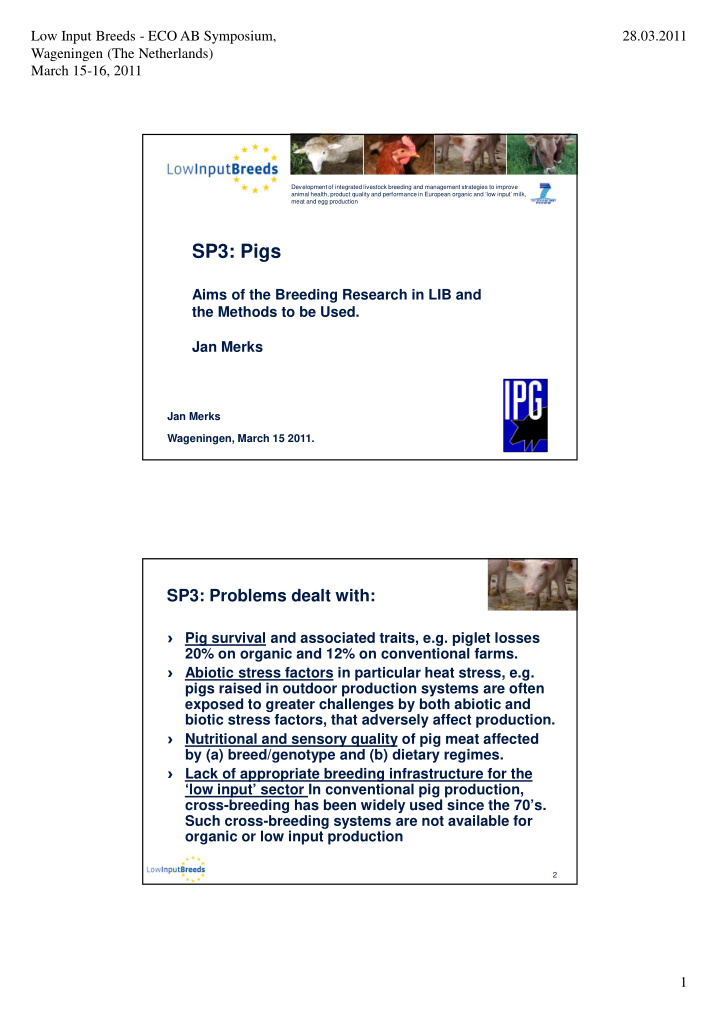



Low Input Breeds - ECO AB Symposium, 28.03.2011 Wageningen (The Netherlands) March 15-16, 2011 Development of integrated livestock breeding and management strategies to improve animal health, product quality and performance in European organic and ‘low input’ milk, meat and egg production SP3: Pigs Aims of the Breeding Research in LIB and the Methods to be Used. Jan Merks Jan Merks Wageningen, March 15 2011. SP3: Problems dealt with: � Pig survival and associated traits, e.g. piglet losses 20% on organic and 12% on conventional farms. � Abiotic stress factors in particular heat stress, e.g. pigs raised in outdoor production systems are often exposed to greater challenges by both abiotic and biotic stress factors, that adversely affect production. � Nutritional and sensory quality of pig meat affected by (a) breed/genotype and (b) dietary regimes. � Lack of appropriate breeding infrastructure for the ‘low input’ sector In conventional pig production, cross-breeding has been widely used since the 70’s. Such cross-breeding systems are not available for organic or low input production 2 1
Low Input Breeds - ECO AB Symposium, 28.03.2011 Wageningen (The Netherlands) March 15-16, 2011 SP3: GOALS � WP3.1 Development of a flower breeding system to improve pig survival and robustness related traits in small populations � WP3.2 Development of management innovations (gilt rearing and lactation systems) on mothering ability of sows and losses of piglets � WP3.3 Effect of traditional, improved and standard hybrid pig genotypes and feeding regimes on carcass, meat and fat quality 3 WP 3.1.1. Selecting suitable genotypes Goal WP 3.1.1. � Identify the most suitable breeds for organic/low input pig production 1. Literature meta-analysis (Month 1-18) ������������������ 2. Survey of organic and low input farms in different macroclimatic regions (Month 1-30) 3. Stakeholder workshop �������������� 4 2
Low Input Breeds - ECO AB Symposium, 28.03.2011 Wageningen (The Netherlands) March 15-16, 2011 WP 3.1.2. Development and implementation of a “flower” breeding systems (FBS) Goal WP 3.1.2. � Develop and implement a suitable breeding structure for organic/low input systems � Develop and implement a genetic fingerprinting approach to select for improved piglet & finisher survival 1. Developing and implement the most viable breeding structure/breed combination (M 12-60) 2. Developing and implement selection for piglet and finisher survival using a genetic fingerprinting approach (M 6-60) 5 New breeding structure along collaboration 6 3
Low Input Breeds - ECO AB Symposium, 28.03.2011 Wageningen (The Netherlands) March 15-16, 2011 WP 3.1.2. Approach (1) �������������������������������������� Economic model analysis Economic model analysis Economic model analysis Economic model analysis --> Most profitable combination of breeding structure and breeds Genetic model analysis Genetic model analysis Genetic model analysis Genetic model analysis --> Predicted genetic progress using different breeding programmes/breeding strategies Most suitable combination of breeds and breeding structure 7 WP 3.1.2. Approach (2) � Methodology development - 124 high quality SNP’s were selected from a total of 450 SNP’s - Quality testing of these SNP’s on various sample types (blood, hairs, swabs) - Development of automatized parental identification in a suitable software environment � Implementation - On Low Input farms in Spain, Brazil and ?? 8 4
Low Input Breeds - ECO AB Symposium, 28.03.2011 Wageningen (The Netherlands) March 15-16, 2011 WP3.1.3. Parameters to reduce heat stress Goal WP 3.1.3. • Quantify genetic variation for parameters that determine temperature neutral zone and effects on pig health and welfare • Design breeding programs that increase temperature neutral zone/robustness 1. Data ANALYSIS from several breeds that have performances under climatal conditions with a wide temperature variation 9 WP3.2. Development of management innovations on mothering ability of sows Two critical moments in the life of piglets • Last days before and during birth + first days of live • Lactation period: birth - weaning Goal WP 3.2. • Effect of rearing gilt system on maternal behaviour (litter 1 + 2) and subsequent liveability and health of piglets (0-6 wk) • Effect of genotype piglet and rearing environment on survival of piglets on liveability before and after weaning (1-6 + 6-10wk) 1.Experiments at Raalte organic farm 10 5
Low Input Breeds - ECO AB Symposium, 28.03.2011 Wageningen (The Netherlands) March 15-16, 2011 WP3.3. Effect of PIG GENOTYPES and FEEDING REGIMES on carcass, meat and fat quality Goal WP 3.3. WP 3.3.1. Effects of, and interactions between, (a) • pig genotype and (b) dietary regimes on carcass, meat and processing quality characteristics � EXPERIMENTAL APPROACH • WP 3.3.2 Effect of genetic, management and dietary factors on carcass and meat quality parameters in European � low input production systems � SURVEY APPROACH 11 SP 3.3.1. Meat quality: `experimental approach SP 3.3.1. Meat quality: `experimental approach … three different genotypes: • AS (Angler Sattelschwein): Old, rare, indigenous breed • Pi*AS: Semi-intensive crossbreed of Piétrain as sire line with a AS-sow • Pi*(DE*DL): Modern hybrid of Piétrain, German Large White and German Landrace PixAS AS Pix(DExDL) … and two different feeding strategies: • Concentrates (straw as roughage source acc. to EC Reg. • Concentrates and roughage (grass-clover-silage) 12 6
Low Input Breeds - ECO AB Symposium, 28.03.2011 Wageningen (The Netherlands) March 15-16, 2011 SP 3.3.2 Meat quality: survey approach Quality of fresh pork: Nutritional quality – n-3 PUFA, antioxidants and/or Sensory quality – skatole Organic and low input systems in D, ES, UK 13 SP3.3.2 Meat quality: survey approach 324 fat samples Background information Country 3 Season (May, Aug, Jan) Season 3 System (pasture/indoor) System 2 Gender (F/ M-C) Farm 4 Breed (? SP1) Gender 2 Feed Repl 3 Sl wt, P2 14 7
Low Input Breeds - ECO AB Symposium, 28.03.2011 Wageningen (The Netherlands) March 15-16, 2011 Federal Research Institute ������������� for Rural Areas, Forestry and Fisheries ����������� Institute of Organic ������ Farming - IOF The authors gratefully acknowledge co-funding from the European Commission, under the Seventh Framework Programme for Research and Technological Development, for the Collaborative Project LowInputBreeds (Grant agreement No 222623) 15 15 8
Recommend
More recommend